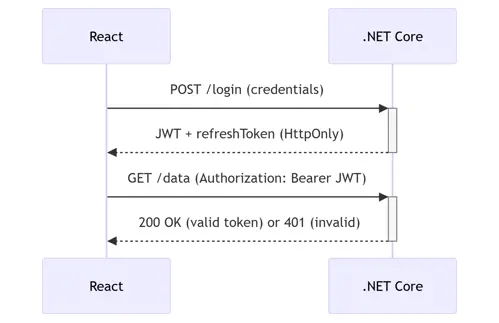Master secure JWT authentication for .NET Core APIs and React frontends. Learn battle-tested implementation strategies, avoid critical security flaws, and implement best practices for enterprise-grade auth.
Master secure JWT authentication for .NET Core APIs and React frontends. Learn battle-tested implementation strategies, avoid critical security flaws, and implement best practices for enterprise-grade auth.
JWTs (JSON Web Tokens) have become the backbone of modern web authentication, powering 78% of new .NET Core and React stacks according to 2025 industry data. But here’s the uncomfortable truth we’ve learned from auditing many client projects:
JWT implementations fail in two ways:
After migrating legacy auth systems like WS-Security to JWT for many clients through our .NET Core and React Development Service, we’ve distilled a hardened blueprint. This guide covers not just implementation but survival tactics for real-world threats.

Unlike sticky server sessions, JWTs are self-contained passports. When implemented correctly:
React Frontend:
.NET Core Backend:
Critical Mistake #1: Using symmetric keys (HMACSHA256) for distributed systems.
Step 1: Asymmetric Key Generation (RSA 2048)
openssl genpkey -algorithm RSA -out private_key.pem -pkeyopt rsa_keygen_bits:2048 openssl rsa -pubout -in private_key.pem -out public_key.pem
Step 2: Configuration in Program.cs
var builder = WebApplication.CreateBuilder(args);
// Load keys from secure storage (Azure Key Vault/AWS Secrets Manager)
var privateKey = Environment.GetEnvironmentVariable("JWT_PRIVATE_KEY");
var publicKey = Environment.GetEnvironmentVariable("JWT_PUBLIC_KEY");
builder.Services.AddAuthentication(JwtBearerDefaults.AuthenticationScheme)
.AddJwtBearer(options => {
options.TokenValidationParameters = new TokenValidationParameters {
ValidateIssuer = true,
ValidateAudience = true,
ValidateLifetime = true,
ValidateIssuerSigningKey = true,
ValidIssuer = "faciletechnolab.com",
ValidAudience = "faciletechnolab.com",
IssuerSigningKey = new RsaSecurityKey(
RSA.Create().ImportFromPem(privateKey) // Asymmetric validation
};
});Note: Symmetric keys are acceptable only for monolithic apps. For microservices, always use RSA.
Pitfall Alert: 92% of JWT leaks originate from frontend storage mistakes.
Secure Token Handling
// auth.service.js
import { jwtDecode } from 'jwt-decode';
export const login = async (email, password) => {
const response = await fetch('/api/auth/login', {
method: 'POST',
headers: { 'Content-Type': 'application/json' },
body: JSON.stringify({ email, password })
});
const { token, refreshToken } = await response.json();
// Store refreshToken as HttpOnly cookie (secure against XSS)
document.cookie = `refreshToken=${refreshToken}; HttpOnly; Secure; SameSite=Strict`;
// Store JWT in memory (vanishes on tab close)
return jwtDecode(token);
};
// ProtectedRoute.jsx
import { createContext, useContext, useEffect, useState } from 'react';
const AuthContext = createContext();
export const AuthProvider = ({ children }) => {
const [user, setUser] = useState(null);
useEffect(() => {
const validateToken = async () => {
try {
// Silent refresh via HttpOnly cookie
const res = await fetch('/api/auth/refresh', { credentials: 'include' });
const { token } = await res.json();
setUser(jwtDecode(token));
} catch (err) {
window.location.href = '/login';
}
};
validateToken();
}, []);
return (
<AuthContext.Provider value={{ user }}>
{user ? children : <div>Loading...</div>}
</AuthContext.Provider>
);
};Practice 1: Token Expiry Strategy
Access Token: 5-15 minutes (limits exposure if leaked)
Refresh Token: 7 days (stored as HttpOnly cookie)
// .NET Core Token Service
public AuthResponse GenerateTokens(User user) {
var accessToken = new JwtSecurityToken(
issuer: _config["Jwt:Issuer"],
audience: _config["Jwt:Audience"],
claims: GetUserClaims(user),
expires: DateTime.UtcNow.AddMinutes(10), // Short-lived
signingCredentials: _signingCredentials
);
var refreshToken = new JwtSecurityToken(
expires: DateTime.UtcNow.AddDays(7)
);
return new AuthResponse {
AccessToken = new JwtSecurityTokenHandler().WriteToken(accessToken),
RefreshToken = new JwtSecurityTokenHandler().WriteToken(refreshToken)
};
}Practice 2: Token Blacklisting for Logouts
Problem: JWTs are stateless – can’t be revoked until expiry.
Solution: Maintain minimal server-side state for blacklisted tokens.
// Redis blacklist in .NET Core
public async Task Logout(string token) {
var expiry = _tokenHandler.ReadToken(token).ValidTo;
await _redis.StringSetAsync($"blacklist:{token}", "revoked",
expiry - DateTime.UtcNow);
}
// In JWT validation:
options.Events = new JwtBearerEvents {
OnTokenValidated = async context => {
var redis = context.HttpContext.RequestServices.GetService<IDatabase>();
if (await redis.KeyExistsAsync($"blacklist:{context.SecurityToken}")) {
context.Fail("Token revoked");
}
}
};Pitfall 1: Role Checks in Frontend Only
Exploit: Hackers bypass React to call APIs directly.
Fix: Always validate roles in .NET Core controllers.
[Authorize(Roles = "Admin")]
[HttpGet("sensitive-data")]
public IActionResult GetSensitiveData() { ... }Pitfall 2: Storing Sensitive Data in JWT
Risk: Tokens decoded at jwt.io expose secrets.
Rule: Never store PII, passwords, or secrets in claims. Use opaque references:
// Bad
{ "email": "user@facile.com", "role": "Admin" }
// Good
{ "sub": "a7f8d0", "scope": "read:data write:data" }Pitfall 3: Not Verifying Token Signatures
Nightmare Scenario: Malicious actor self-issues "admin" tokens.
Solution: Always validate on backend (automatic with .AddJwtBearer()).
Scenario 1: Microservices Auth
Strategy: Central auth service issues JWTs → services validate signatures independently.
// In ProductService Program.cs
services.AddAuthentication(JwtBearerDefaults.AuthenticationScheme)
.AddJwtBearer(o => {
o.Authority = "https://auth.facile.com";
o.Audience = "product-service";
});Scenario 2: Permission Granularity
Problem: Role-based auth too coarse for complex apps.
Solution: Policy-based authorization with custom requirements.
// In Program.cs
services.AddAuthorization(o => {
o.AddPolicy("Over18", p =>
p.RequireClaim("Age", "18", "19", "20"));
});
// In Controller
[Authorize(Policy = "Over18")]
[HttpGet("alcohol-products")]
public IActionResult GetAlcoholProducts() { ... }Conclusion: Security Is a Process, Not a Feature. JWTs offer unparalleled flexibility for .NET Core and React architectures but demand rigorous discipline:
"The most secure JWT token is the one that never exists longer than necessary."
See our work on a developer mentoring platform that handles high concurrent user loads with a scalable .NET Core backend and responsive React frontend.